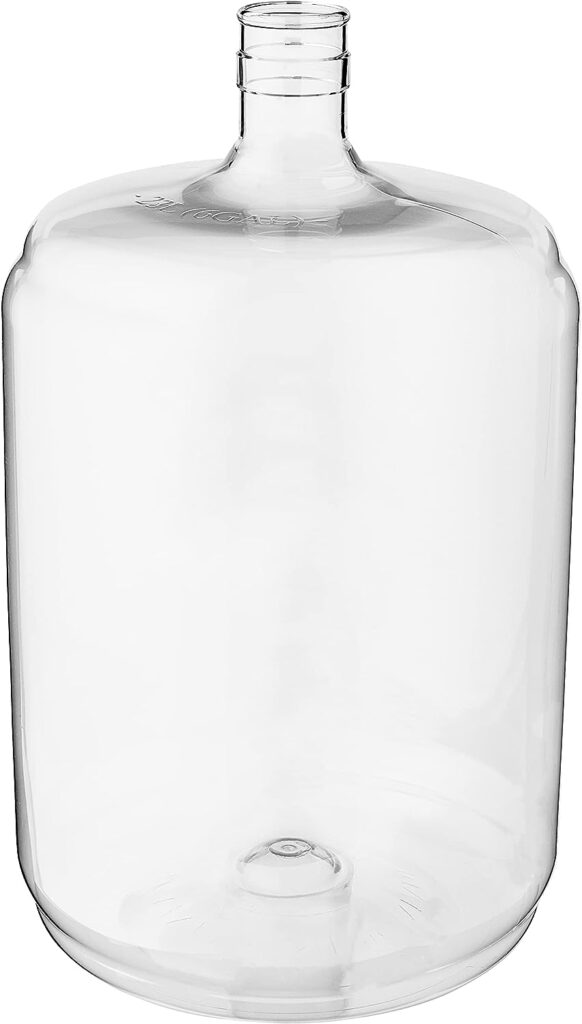Choosing the right fermentation vessel – whether to use carboys or buckets when homebrewing. Let’s explore the pros and cons of each option, so you can make an informed decision based on your personal preferences and homebrewing goal.
Carboys
Carboys are round containers made of glass or plastic, made to hold liquid during the fermentation process. They are a popular choice among homebrewers due to transparency, which helps with the monitoring of the fermentation process. Glass carboys are also non-reactive, so they won’t affect the flavor of your beer.
Pros:

- Transparency: Glass carboys allow for easy monitoring of the fermentation process, making it easy to spot any potential issues.
- Non-reactive: Glass carboys are non-reactive, so they won’t affect the flavor of your beer.
- Airtight: Glass carboys are airtight, which helps prevent oxygen from entering the container and spoiling the beer.
- Durable: Glass carboys are durable and can last for many years if properly cared for.
Cons:
- Fragile: Glass carboys are fragile and can break easily, which can be dangerous and result in a loss of beer.
- Heavy: Glass carboys are heavy and can be difficult to move, especially when full of beer.
- Expensive: Glass carboys are more expensive than plastic buckets.
Plastic buckets
Most people get started brewing beer in a bucket because it’s simple and cheap. There are a ton of homebrewing kits, and most of them come with plastic buckets.
They come in a variety of sizes and are made of food-grade plastic that won’t affect the flavor of your beer.

Pros:
- Inexpensive: Plastic buckets are inexpensive and widely available.
- Lightweight: Plastic buckets are lightweight and easy to move, even when full of beer.
- Durable: Plastic buckets are durable and can last for many years if properly cared for.
- Easy to clean: Plastic buckets are easy to clean and sanitize.
Cons:
- Opaque: Plastic buckets are opaque, which makes it more difficult to monitor the fermentation process.
- Reactive: Plastic buckets can be reactive with certain ingredients, such as hop oils, which can result in off-flavors in your beer.
- Not airtight: Plastic buckets are not airtight, which can allow oxygen to enter the container and spoil the beer.
- Scratches: Over time, plastic buckets can develop scratches that can harbor bacteria and affect the flavor of your beer.
Both carboys and plastic buckets have their advantages and disadvantages, so the decision ultimately comes down to personal preference and brewing goals. If transparency, non-reactivity, and airtightness are major issues for you, a glass carboy might be the best choice for you. However, if you lean to affordability, durability, and ease of use, a plastic bucket may be a better option. Whichever vessel you choose, make sure to clean and sanitize it properly before use to ensure the best possible outcome for your homebrew.
Why use a carboy instead of a bucket?
- Transparency: Carboys are often made of glass, which allows homebrewers to see the fermentation process as it occurs. This can be helpful for monitoring the progress of the fermentation and detecting any potential issues.
- Non-reactive: Glass carboys are non-reactive, which means that they won’t react with the beer and alter its flavor. This is important because certain materials, such as some plastics, can potentially affect the flavor of the beer.
- Airtight: Carboys are often designed to be airtight, which can help prevent oxygen from entering the container and spoiling the beer. This can be particularly important during the initial stages of fermentation when the yeast is consuming the sugars and producing carbon dioxide.
- Durability: Glass carboys are generally quite durable and can last for many years if properly cared for. This means that homebrewers may be able to use the same carboy for multiple batches of beer, which can help save money in the long run.
- Aesthetics: Some homebrewers simply prefer the look of a carboy to a bucket. Carboys can be quite visually appealing, particularly if they are made of glass and allow the beer to be seen during the fermentation process.
Overall, while both carboys and buckets have their advantages and disadvantages, using a carboy can be a great option for homebrewers who prioritize transparency, non-reactivity, airtightness, durability, and aesthetics.
Why is it called a carboy?
The word “carboy” is a Persian word “qarabah”, which means “large jug” or “barrel.” Carboys were traditionally used to transport and store liquids such as water, wine, and oil. The shape of the carboy, tall and narrow and has a small neck, makes it easy to transport and pour liquids without spilling.
For homebrewing, the term “carboy” refers to a vessel used for fermenting the beer. These carboys are typically made of glass or plastic and are designed to hold liquids during the fermentation process. The tall, narrow shape of the carboy makes it easy to handle and store, while the small neck allows for a fermentation lock to be attached to prevent outside air from entering the container.
Overall, the term “carboy” has been used for centuries to describe a type of large jug or barrel, and in the context of homebrewing, it refers to a specific type of fermentation vessel that shares some of the same characteristics as traditional carboys.


0 Comments
Brewing Terminology - Brew Fuse
[…] Carboy […]